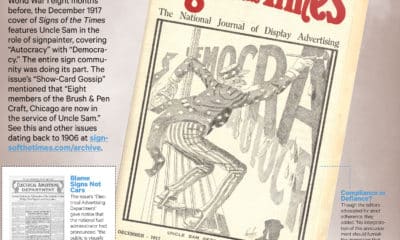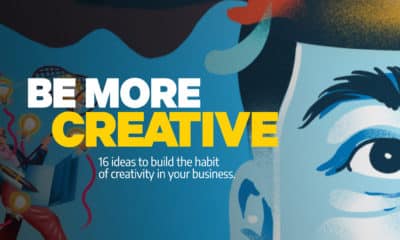
New Ideas Revolutionizing the Sign Business
Four sign pros talk AI, new markets, disruptors and an imminent generational shift.
Published
5 months agoon
WHAT HAPPENS WHEN you place a crystal ball in front of four expert signmakers to predict the future? Signs of the Times Editor-in-Chief Mark Kissling, who organized just such a meeting in January, moderated an intelligent and enlightening discussion about current and future trends in the business — artificial intelligence (AI), growth markets, disruptions in the industry, hiring and training new employees. Taking part in the virtual roundtable were Pablo Guerrero, president of Amigo Arts (Monroe, WA); Earl Walker, president of Image360 Tucker, (Tucker, GA); John Yarger, CEO of North American Signs (South Bend, IN); and Teresa Young, president Sign Biz, (Dana Point, CA). These four experts represent different parts of the US as well as different shop sizes, sign services, demographics and viewpoints.

THE IMPACT OF AI
One of the hottest trends making headlines right now is AI. How will it affect the signmaking industry? The four-person discussion began by addressing AI’s current role and use in the sign industry and where it will be expanding. Young, who owns a consultancy company with over 100 member sign companies, proclaimed that AI is here to stay — large and in charge. Her viewpoint comes from knowledge gathered from hundreds of signshops that feed her information organically.
“The most intriguing use of AI for me is virtual people used on electronic digital signs inside convenience stores,” she says. “There are three Chevron trial stores in southern California, which depict a virtual sommelier who you can ask questions about which wine to pair with what type of meal you are having. They are very realistic.”
On the traditional sign side, Young says, AI is exploding. In the next 12-18 months she predicts that AI will be able to easily produce vehicle wrap designs for nearly any make and model using available templates and vector files. She also sees AI being used by signmakers to generate sign messages and other written material.
Guerrero, who owns a small, full-service custom signshop, was more cautious about AI’s impact. “AI will be a good prompt for ideas and concepts as well as streamlining the design process, but I don’t think it’s refined enough for production,” he says. “I’m seeing too many consistent frameworks through AI. Yes, AI can help build interactive projects and give you a recipe where to start but at a certain point, there will be a bland design aspect to it and you’ll need physical people to push it forward.”
Yarger, who oversees a large operation that produces signs for national installation, tended to agree with Guerrero. “When you ask AI to do your writing, it is helpful to give you structure, but the unique voice and final editing still need to be there and [right now] that can only come from a human,” he says. “AI is certainly great for all sorts of office texts or starter outlines.”

PHOTO: ISTOCKPHOTO
GROWTH MARKETS
Another hot topic is the anticipated growth of certain markets or industries. Where should signmakers concentrate their sales forces in the next three to five years? Which markets will see the greatest rate of growth in revenue during that time, and why? The panelists named a number of markets to watch, including multi-family dwellings and restaurants.
“Covid stalled the growth of new restaurants but we’re now seeing an uptick in restaurant openings and I believe that will continue for the next three years,” Yarger says. “People are once again going out in droves. There are new signage concepts going into these spaces, both locally and national chains as well.”
In the Atlanta metro area, an enormous number of new apartments are being built due to the need for affordable housing, says Walker, who operates a franchise shop along with his wife. “Typically when new management comes in they switch out the graphics,” he says. Another growth market: drive-thru restaurants. “One of my best customers got a boost in their business due to the growth in drive-thru. We did a wonderful build out for them.”
Young agrees: “Multi-family housing will be booming for the next three to five years or beyond. There’s massive growth and opportunities for the sign industry.”
Guerrero has seen a resurgence in handmade custom signage. “It’s on a 10-year cycle,” he says. “It was popular back in 2010 and now we’re getting contracts for it again. Here in our Seattle metro market, people are doing more, small boutique things and asking for projects that are more highly crafted to be tailored to their small, niche demographic. For example, churches not only want handcrafted furniture but customized signage as well. And we’ve taken on customers like crazy mini-golf places lately. The cool stuff dried up and now it is coming back.”
Walker agreed: “People want to express themselves more and, as signmakers, we can be their channel to allow them to do that.”

PHOTO: ISTOCKPHOTO
NEW BUSINESS IDEAS AND DISRUPTIONS
Next, the panel moved to sharing the best new ideas that applied to their sign businesses. Rapt attention was paid to Guerrero who described his usage of augmented reality (AR — not to be confused with VR, virtual reality) as a value-added offering to his customers. “Augmented reality is very forward thinking,” he says. “I’ve used it for a customer’s perspective monument sign. Using AR, I could allow the customer to walk around the entire sign and see how the sign would look in their foyer, all by using this new Google technology.” Or, say you’re designing a food court sign for a customer. You can anchor that sign where it’s going to be and the customer can walk with their phone under the sign, around the sign, and see it as though it were already installed. “It’s a great sales tool and will be used more and more in the next three years,” Guerrero adds.
Which possibly disruptive influences to the sign industry need to be addressed? Two topics rose to the forefront: supply-chain disruptions and increasing retirements of sign business owners — not oft-cited aging out of skilled installers.
Supply chain disruptions continue to plague manufacturers, including signmakers. While it started during Covid, Yarger says, these disruptions continue. “Everything is stretched. Like last summer, due to the Barbie movie, everyone was trying to find pink but it was difficult,” he says. “The ongoing China situation is fraught with problems. I hope it doesn’t get worse and become a crisis.”
Another ongoing disruption? What Walker calls “veterans cashing in their chips.” ST’s 2024 Big Survey found that nearly half of respondents are 60 or older and though 19% never plan to retire, that still portends a tsunami of retirement that may crest anytime now and flood the industry over the next decade or more. “I went to visit one of my [subcontracting] fabricators recently and was surprised to learn that he had sold the business,” Walker says. “He’s not the only experienced and skilled tradesman to retire. This will be a disruptive influence in the market until we gain some new hires that are well-trained to pick up the skills that have been lost with retirees.”
Advertisement
PHOTO: ISTOCKPHOTO
HIRING
Using that discussion about retirement and losing experienced workers, the group transitioned their focus to one of the major disruptive factors today for signmakers and the greater realm of businesses: hiring new employees. Workers are short in number, turnover rates are high, and finding reliable employees with the best skillset is hard. It’s a hiring crisis. What can owners and managers at sign companies do to attract and retain new and young employees?
Walker emphasizes education. He likes to talk to students about different projects and stress that signage is everywhere. Look at your grocery stores, he says, or the fancy signage at a local Walmart. Young took it upon herself to make a video to show kids the world of signs. Her goal was to pique their interest and get young students thinking about signage as a career.
Guerrero plans to cut back his office hours and begin teaching. “Our high school offers CTE (Career Technical Education). I’m looking forward to getting into the classroom and showing students how to take a pencil sketch on a napkin, creating the design, selling it and seeing it through production,” he says. “It’s my way to give back to the industry.” Guerrero wants to make it a fun class and show the students how to wear many hats. “I want them to be a rockstar signshop designer,” he says. “I was once just like them — a kid drawing designs on my computer that eventually led me to open my own business.”
On the other side of the coin, the panelists encouraged their peers to “fill up the slack” and change their attitudes toward younger employees. A generational shift is taking place from aging Baby Boomers through Millennials and Gen Z; it’s up to sign company owners to learn how to deal with them as both customers and employees.
“Find a 25- to 35-year-old who is eager, teachable and has a good character,and create a novel environment that is exciting and fun,” Young says. “Rather than a typical workday, offer to hire them as part of a bank of installers and designers who will only have to work for hours a week when they choose,” she says. “They get their own free time within the confines of your rules and good systems, and you’ve created an environment that is perfect for them. Give them a virtual checklist to communicate with them at home.”
But the group agreed training is the key. At Yarger’s North American Signs, management works to develop an atmosphere of collegiality and comradery. Beyond that, management needs to look at employees as less permanent and more fluid. “If I can get two years out of this person, it’s okay. If I get more that’s awesome,” he says. “Some new hires are not the right fit and it’s important not to take an attitude toward them because they might eventually come back to you. When they come back, they’ll have more experience and that’s valuable to me and my company. In turn, they’ll value us more because they can compare us to other experiences and value what we have to offer.”
Walker concurs. “The days of staying with a business for 25 years are over. The days of getting that gold watch are over,” he says. “When you are working with designers, if they stay past two years, that’s great. But as an owner I’ve come to the conclusion that I have to let my old way of thinking go. I have to take a different approach. Yes, it’s tough. But every time we hire a new designer, she or he brings in fresh ideas. That’s a positive.”
Advertisement
PHOTO: ISTOCKPHOTO
TRAINING
Finally, the panelists noted that there can never be enough training after finally finding the perfect new team member. By training a person closely, a manager will be able to assess how well positioned the person is for their job and the company and perhaps weed out a new hire that won’t make it. As Young described, “it’s like having two full-time jobs. You’re running your business and you’re training, or you’re managing your department and you’re training. It’s exhausting,” she adds.
One of their tips is to create a mentor for the new hire. Studies have found that a mentor or a buddy system helps to retain a new employee. With one, the newbie would have someone to eat lunch with, to ask questions about company policy and to form a friendship. Often these mentors become both a friend and ally within the company and perhaps stay with them throughout their career.
Due to the lack of new hires, today’s managers might need to step up to the plate. “When I was in my 20’s doing super-creative stuff, the market was filled with people like me,” says Guerrero. “Now I’m in my 40’s; there aren’t people filling up the slack. Today, we’re charged with teaching this younger generation with what we need and navigating the idiosyncrasies of their particular age.” We’re in a climate, he feels, where people are a bit less willing to take risks and start new businesses. “Perhaps it is people like us that will need to kickstart a resurgence and get more involved,” he says.
If you have a revolutionary idea you’d like to share, email it to editor@signsofthetimes.com.
Debora Toth is a freelance writer who has covered the graphic arts industry for more than 20 years. She is headquartered in Farmingdale, NY. Contact Debora at debora.toth@gmail.com.

SPONSORED VIDEO
Who’s Steering Signs of the Times?
We dive into the history of the sign industry’s oldest trade journal, highlighting some interesting facts about how it all started to where it’s headed. Did you know that Signs of the Times is nearly 120 years old?
You may like

Canon U.S.A. to Host Webinar on AI Integration in Business

21 Highlights from the American Sign Museum Main Street Expansion

From Chips to Hip
Subscribe

Bulletins
Get the most important news and business ideas from Signs of the Times magazine's news bulletin.
Most Popular
-

 Tip Sheet2 weeks ago
Tip Sheet2 weeks agoSign Tips for Construction Fence Graphics and CNC Tables
-

 Real Deal2 weeks ago
Real Deal2 weeks agoA Wrap Shop Plots to Take Back a Poached Installer
-

 Paula Fargo3 days ago
Paula Fargo3 days agoSelling Your Sign Company Via the Franchising World
-

 Photo Gallery20 hours ago
Photo Gallery20 hours ago21 Highlights from the American Sign Museum Main Street Expansion
-

 Signs of the Times4 days ago
Signs of the Times4 days agoDecember 1917 Signs of the Times Cover: Safe for Democracy
-

 News1 week ago
News1 week agoMUTOH Introduces New Single-Pass ADA Features
-

 Special Report1 week ago
Special Report1 week agoThe Wide World of Non-English Signs
-

 News2 weeks ago
News2 weeks agoWells Fargo Sign Removed From Jacksonville Tower












